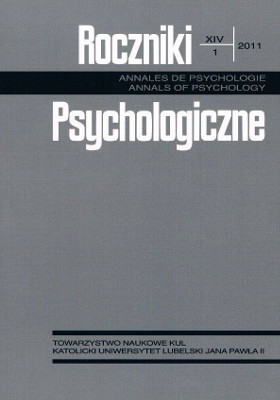O przewadze koniunkcji nad alternatywą, czyli jak skuteczniej pomagać terapeutom
Bibliografia
Aleksandrowicz, J. W. (2010). Kilka uwag o procesach integracji teorii psychoterapii. Psychiatria i Psychoterapia, 6, 3-10.
Castelnuovo, G., Faccio, E., Molinari, E., Nardone, G., Salvini, A. (2004). A critical review of empirically supported treatments (ESTs) and common factors perspective in psychotherapy. Neuropsychology, 1, 208-224.
Crits-Christoph, P. (1997). Limitations of the dodo bird verdict and the role of clinical trials in psychotherapy research: Comment on Wampold et al. Psychological Bulletin, 122, 216-220.
Howard, K. I., Kopta, S. M., Krause, M. S., Orlinsky, D. E. (1986). The dose-effect relationship in psychotherapy. American Psychologist, 41, 159-64.
Howard, K. I., Moras, K., Brill, P. L., Martinovich, Z., Lutz, W. (1996). Evaluation of psychothe-rapy. Efficacy, effectiveness, and patient progress. American Psychologist, 51, 1059-1064.
Institute of Medicine (2001). Crossing the Quality Chasm: A new health system for the 21st century. Washington, DC: National Academy Press.
Kępiński, A. (1992). Rytm życia. Kraków: Sagittarius.
Lambert, M. J., Whipple, J. L., Smart, D. W., Vermeersh, D. A., Nielsen, S. L., Hawkins, E. J. (2001). The effects of providing therapists with feedback on patient progress during psychotherapy: Are outcomes enhanced? Psychotherapy Research, 11, 49-68.
Levant, R. F. (2004). The empirically validated treatments movement: A Practitioner/educator perspective. Clinical Psychology: Science and Practice, 11, 219-224.
Nathan, P. E., Stuart, S. P., Dolan, S. L. (2000). Research on psychotherapy efficacy and effectiveness: Between Scylla and Charybdis? Psychological Bulletin, 126, 964-981.
Paluchowski, J. (2010). Spór metodologiczny czy spór koncepcji – badania ilościowe vs jakościowe. Roczniki Psychologiczne, 13, 7-21.
Wampold, B. E., Mondin, G. W., Moody, M., Stich, F., Benson, K., Ahn, H. (1997). A meta-analysis of outcome studies comparing bona fide psychotherapies: Empirically, “all must have prizes”. Psychological Bulletin, 122, 203-215.
Castelnuovo, G., Faccio, E., Molinari, E., Nardone, G., Salvini, A. (2004). A critical review of empirically supported treatments (ESTs) and common factors perspective in psychotherapy. Neuropsychology, 1, 208-224.
Crits-Christoph, P. (1997). Limitations of the dodo bird verdict and the role of clinical trials in psychotherapy research: Comment on Wampold et al. Psychological Bulletin, 122, 216-220.
Howard, K. I., Kopta, S. M., Krause, M. S., Orlinsky, D. E. (1986). The dose-effect relationship in psychotherapy. American Psychologist, 41, 159-64.
Howard, K. I., Moras, K., Brill, P. L., Martinovich, Z., Lutz, W. (1996). Evaluation of psychothe-rapy. Efficacy, effectiveness, and patient progress. American Psychologist, 51, 1059-1064.
Institute of Medicine (2001). Crossing the Quality Chasm: A new health system for the 21st century. Washington, DC: National Academy Press.
Kępiński, A. (1992). Rytm życia. Kraków: Sagittarius.
Lambert, M. J., Whipple, J. L., Smart, D. W., Vermeersh, D. A., Nielsen, S. L., Hawkins, E. J. (2001). The effects of providing therapists with feedback on patient progress during psychotherapy: Are outcomes enhanced? Psychotherapy Research, 11, 49-68.
Levant, R. F. (2004). The empirically validated treatments movement: A Practitioner/educator perspective. Clinical Psychology: Science and Practice, 11, 219-224.
Nathan, P. E., Stuart, S. P., Dolan, S. L. (2000). Research on psychotherapy efficacy and effectiveness: Between Scylla and Charybdis? Psychological Bulletin, 126, 964-981.
Paluchowski, J. (2010). Spór metodologiczny czy spór koncepcji – badania ilościowe vs jakościowe. Roczniki Psychologiczne, 13, 7-21.
Wampold, B. E., Mondin, G. W., Moody, M., Stich, F., Benson, K., Ahn, H. (1997). A meta-analysis of outcome studies comparing bona fide psychotherapies: Empirically, “all must have prizes”. Psychological Bulletin, 122, 203-215.
Opublikowane
2019-03-29
Numer
Dział
Dyskusja
Copyright (c) 2011 Roczniki Psychologiczne

Utwór dostępny jest na licencji Creative Commons Uznanie autorstwa – Użycie niekomercyjne – Bez utworów zależnych 4.0 Międzynarodowe.


